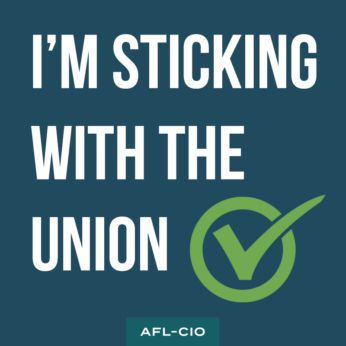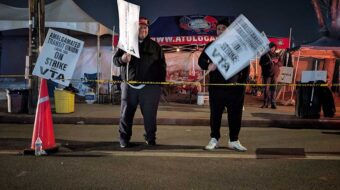
WASHINGTON—In a predictable and mean ruling, the five-man Republican-named majority of the U.S. Supreme Court lowered the boom on unions representing state and local government workers, declaring every single such worker in the country a “free rider,” able to take union services without paying one red cent for them.
The court’s 5-4 ruling in Janus vs AFSCME District Council 31 means all those workers in non-right-to-work states can now use union services for free, just as those in RTW states do. That will deprive unions of hundreds of thousands of members and millions of dollars in agency fees, weakening their ability to represent and advocate for all workers.
GOP President Donald Trump, who appointed the key justice, Neil Gorsuch, summarized the political impact in a tweet: “Big loss for the coffers of the Democrats!”
The decision effectively makes every state and local government workplace – schools, fire departments, police stations, sanitation departments, state child welfare agencies, public hospitals and more – right-to-work sites when present union contracts expire.
Writing for the majority, Justice Samuel Alito – who first prodded the right wing to start Janus and similar cases – bluntly said laws letting unions represent state and local workers and collect “fair share” fees from non-members in those units, violate the non-members’ 1st Amendment free speech rights.
He totally adopted the right wing’s arguments.
“Without those fees, employees have every incentive to free-ride on union dues paid by others,” Justice Elena Kagan, writing for the four dissenters, retorted.
The court’s decision culminates a long campaign by the venal and vicious National Right to Work Committee, its legal defense fund and its corporate backers, led by the stridently anti-worker Koch brothers – rich oilmen from Kansas – to, as one of their advocates put it, “defund the left” by cutting off its cash. Organized labor is a key source of people and contributions for progressive causes.
The ruling also shows the impact of elections on the High Court. The last time the justices heard a similar case, they tied 4-4, after then-Justice Antonin Scalia died. He had been counted on the be the fifth anti-union vote. Trump named right-winger Gorsuch to replace Scalia. Given his prior record on a federal appeals court, unions expected him to be the fifth vote against workers. He was.
Unions blasted the ruling and vowed to shoulder on, re-signing current state and local government worker members and signing up new ones, regardless of the Janus case.
The court majority “abandons decades of commonsense precedent. In this case, a bare majority of the court, over the vigorous dissent of four justices, has conceded to the dark web of corporations and wealthy donors who wish to take away the freedoms of working people,” AFL-CIO President Richard Trumka said.
“Until it is overturned, this decision will be a political stain on what is intended to be the most honorable, independent body in the world. But more importantly, it will further empower the corporate elites in their efforts to thwart the aspirations of millions of working people standing together for a better life.”
But unions are fighting back through increased organizing successes, Trumka retorted. He noted “more than 14,000 workers recently formed or joined unions in just a single week” and union membership grew by 262,000 last year nationwide. “
“The corporate narrative of the labor movement’s downfall is being dismantled by working people every single day. We have never depended on any politician or judge to decide our fate and we aren’t about to start now.”
In a phone text, the fed added: “SCOTUS just ruled for corporate greed but workers’ rights are still constitutional. Pledge to stick with the union now.”
“We are extremely disappointed the Supreme Court has taken the side of the powerful few, but we’re more determined than ever to keep our union strong, standing up for public services and the working people who provide them,” said Roberta Lynch, executive director of AFSCME Council 31 in Illinois, the loser in the case.
As evidence, she pointed to the federal government, which is effectively a right-to-work site, and without the “agency fees,” which the state laws permit. The agency fees require non-members represented by the union – such as Mark Janus, a child welfare worker in Illinois – to pay only the costs of negotiating contracts and enforcing them.
But Janus and the RTW crowd, which recruited him and funded the case, argued even that broke his 1st Amendment rights of free speech, by forcing him to pay – a form of speech, the justices said – for positions he disagrees with on public issues. Alito and the court majority bought that argument, hook, line and sinker.
Dissenting Justices Kagan, Sonia Sotomayor, Stephen Breyer and Ruth Bader Ginsburg – all named by Democratic presidents — sharply disagreed.
“Today, the court succeeds in its 6-year campaign to reverse” the 1977 Abood decision that set up the agency fee system, Kagan, wrote for them. Abood she added, “was a paradigmatic example of how government can regulate speech in its capacity as an employer,” by drawing a line between free speech rights of government workers as citizens and as workers. “Not any longer.”
The majority’s ruling “will have large-scale consequences,” Kagan warned. “Public employee unions will lose a secure source of financial support. State and local governments that thought fair-share provisions furthered their interests” in workplace peace and efficiency “will have to find new ways of managing their workforces. And across the country, the relationships of public employees and employers will alter in both predictable and wholly unexpected ways.”
“Rarely, if ever, has this court overruled a decision – let alone one of this import – with so little regard for principles” and precedent, Kagan said.
While unions vowed to continue organizing – and re-organizing – their state and local government members, a recent analysis by the University of Illinois Labor Education Service and the Illinois Economic Policy Institute put numbers on the losses Kagan forecast.
While the two did not say how much money unions would lose – due to different expiration dates of all the state and local government contracts involved – they calculated that once the ruling takes full effect, public worker unions would lose 726,000 members over time.
The top losses would be in California (-189,000 members), New York (-136,000), New Jersey (-50,000), Illinois (-49,000) and Ohio (-40,000). Teachers unions would lose 88,000 members. AFSCME Council 31, which represents Illinois state and local government workers and which lost the case, has approximately 75,000 members, 80 percent of them state and local government workers.
And the average state and local government worker would lose $1,810 yearly in pay (3.6 percent), with teachers losing even more (5.4 percent), the study said. Nationwide, state and local government workers would lose $16.8 billion over time in pay.











